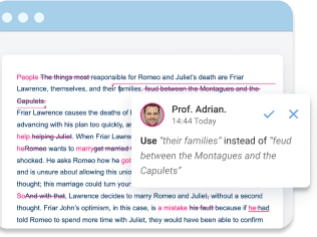Beside vs. Besides: Grammar Essentials
Table of contents
“Beside” and “besides” are two words that often confuse English learners. While they are similar in spelling and pronunciation, they have different meanings and uses.
“Beside” refers to physical proximity, meaning “next to” or “at the side of,” while “besides” is used to indicate addition or an alternative, meaning “in addition to” or “moreover.”
What is the Difference Between “Beside” and “Besides”?
Using “Beside” – Preposition of Proximity
“Beside” is primarily used as a preposition to indicate physical or metaphorical proximity. It is used to mean “next to” or “at the side of.”
Example: “The cat sat beside the fire.”
Here, “beside” shows that the cat is sitting next to the fire. It refers to the physical location of one object in relation to another.
Another example could be:“She stood beside him during the ceremony.”
In this case, “beside” signifies being physically next to someone during an event.
Using “Besides” – Preposition and Adverb
- As a Preposition: “Besides” is used as a preposition to mean “in addition to” or “apart from.” It introduces something extra or adds information.
Example:“Besides chocolate, she also likes vanilla.”
Here, “besides” suggests that her liking is not limited to chocolate; it also includes vanilla.
- As an Adverb: “Besides” can also be used as an adverb to mean “moreover” or “furthermore,” typically used to add another point or reason.
Example: “I don’t want to go out tonight. Besides, I need to save money.”
In this sentence, “besides” adds an additional reason why the speaker doesn’t want to go out.
Additional examples of using “besides” as an adverb:
-
“I don’t like horror movies. Besides, they’re too scary for me.” – This sentence uses “besides” to introduce another reason for the speaker’s preference.
-
“He didn’t study for the test. Besides, he didn’t attend the review session.” – Here, “besides” introduces a further reason for why he didn’t do well.
Understanding the difference between “beside” and “besides” ensures clearer communication in both academic and everyday writing. “Beside” refers to physical or metaphorical proximity, while “Besides” introduces additional information or reasons.
Using “beside” and “besides” correctly in your writing ensures clear and effective communication.
-
“Beside” refers to a position next to something or someone, either physically or metaphorically.
-
“Besides” introduces additional information or reasons, either as a preposition (“in addition to”) or as an adverb (“moreover”).
Proper usage of these words helps avoid confusion, especially in academic or professional writing. By understanding when to use each word, you can express your ideas more accurately and enhance the clarity of your communication.
When editing an essay paper, it is crucial to review each word carefully to ensure proper usage, including words like ‘beside’ and ‘besides.’ Similarly, understanding the proper use of terms like dispose and dispose of can help clarify your writing and make it more precise.
Examples of Common Phrases:
“Beside the point” – This means “irrelevant” or “not related to the main issue.”
“His argument is beside the point; we are discussing the budget, not his personal life.”
“Beside oneself” – This means “extremely agitated” or “in distress.”
“She was beside herself with worry when she couldn’t find her keys.”

Comparison Table: “Beside” vs. “Besides”
This comparison table simplifies the understanding of when and how to use “beside” and “besides”. By highlighting their differences in part of speech, meaning, and usage contexts, it becomes easier for the reader to recognize the appropriate time to use each word.
| Aspect | Beside | Besides |
|---|---|---|
| Part of Speech | Preposition | Preposition or Adverb |
| Meaning | Indicates physical or metaphorical proximity (next to, at the side of) | As a preposition, means “in addition to” or “apart from”; as an adverb, means “moreover,” “furthermore,” or “besides that” |
| Example (Preposition) | “The cat sat beside the fire.” | “Besides the chocolate, she also likes vanilla.” |
| Example (Adverb) | – | “I don’t want to go out tonight. Besides, I have work to do.” |
| Formality | Can be used in both formal and informal contexts | More commonly used in informal contexts, though can also be used in formal settings when adding additional information |
| Contextual Use | Used to describe something physically next to something else or in close proximity | Used to add extra information, an alternative reason, or to introduce something additional |
| Common Idioms | “Beside the point” (irrelevant); “Beside oneself” (extremely agitated) | “Besides the fact” (dismisses a point), “besides that” (adds an additional argument) |
| Punctuation | Generally doesn’t require a comma after it | Typically, a comma follows “besides” when used as an adverb to introduce an additional point |
Examples of Writing Beside
In this section, you will be able to find examples of how beside is actually written in a sentence. This knowledge can go a long way in teaching you how to be a successful student and get good grades. Not to mention, it will also emphasize even more differences between these two words.
For instance, how you can use beside and also in the same sentence:
- I know it is a bad habit but I keep my phone beside my bed and also keep the volume on high.
- The best friends sit besideeach other for every class.
- You should always place the water beside your plate when eating
Another thing that you may be wondering about regarding this word is a popular saying. As such, it may be confusing for you whether you should write beside the point or besides the point. Understanding where to put comma in such expressions can help clarify meaning. The correct use of this word is “beside the point”.
Examples of Writing Besides
Finally, let’s see how you can use besides in a sentence. This can be a little trickier for some, considering the definition of the word. Thus, you may speculate about “How to use the word besides correctly?”
The following examples should clear it up for you:
- I don’t want to go dancing tonight; besides, I don’t have the right shoes for it.
- Do you have any juice besides the orange and mango?
And if another question that you had was, “Can we start a sentence with the word besides?”, the answer to this question would be yes. Just make sure to always place a comma after the word when doing so.
Test Your Knowledge on “Beside” and “Besides”
Instructions: Read each question carefully and choose the correct answer. After selecting an answer, a brief explanation will appear, helping you understand the usage of “beside” and “besides.”
1. Choose the correct sentence:
-
A) “She sat beside the desk during the meeting.”
-
B) “She sat besides the desk during the meeting.”
2. Which sentence correctly uses “besides” as an adverb?
- A) “I don’t want to go to the concert besides I need to finish my homework.”
-
B) “I don’t want to go to the concert. Besides, I need to finish my homework.”
3. Fill in the blank: “The cat sat ___ the fire.”
-
A) beside
-
B) besides
4. Choose the correct sentence:
-
A) “Besides being tired, he also had a headache.”
-
B) “Beside being tired, he also had a headache.”
5. What does the phrase “beside the point” mean?
-
A) It means the topic is irrelevant or not related to the main discussion.
-
B) It means the point is located next to something.
6. Which of the following is the correct use of “besides” as a preposition?
-
A) “Besides being tired, she was also hungry.”
-
B) “She was beside the tired, besides being hungry.”
7. Fill in the blank: “We walked ___ the beach during our vacation.”
-
A) beside
-
B) besides
8. Choose the correct sentence:
-
A) “I don’t think he’ll come. Besides, he’s probably busy with work.”
-
B) “I don’t think he’ll come, beside he’s probably busy with work.”
9. Which of the following sentences correctly uses “beside”?
-
A) “The book is beside the table.”
-
B) “The book is besides the table.”
10. Choose the correct sentence:
-
A) “Beside that, I have no objections.”
- B) “Besides that, I have no objections.”
Answers:
- A) “She sat beside the desk during the meeting.” / Explanation: “Beside” is a preposition indicating physical proximity or being next to something, so it’s the correct choice in this context.
- B) “I don’t want to go to the concert. Besides, I need to finish my homework.” / Explanation: “Besides” is correctly used as an adverb here to introduce an additional reason for not going to the concert.
- A) beside / Explanation: “Beside” is used to indicate physical proximity, meaning next to something. “The cat sat beside the fire” means the cat was physically near the fire.
- A) “Besides being tired, he also had a headache.” / Explanation: “Besides” is used correctly here to introduce an additional point (having a headache in addition to being tired).
- A) It means the topic is irrelevant or not related to the main discussion. / Explanation: “Beside the point” is an idiomatic expression used to indicate that something is not relevant to the main issue at hand.
- A) “Besides being tired, she was also hungry.” / Explanation: “Besides” correctly introduces an additional point, indicating that she was not only tired but also hungry.
- A) beside / Explanation: “Beside” is used to indicate physical proximity, meaning walking next to or along the beach.
- A) “I don’t think he’ll come. Besides, he’s probably busy with work.” / Explanation: “Besides” is used here as an adverb to introduce an additional reason why he won’t come.
- A) “The book is beside the table.” / Explanation: “Beside” is correctly used here to indicate the book is physically next to the table.
- A) “Besides that, I have no objections.” / Explanation: “Besides” is correctly used here to introduce an additional point or reason for not objecting.
Final Thoughts
It doesn’t matter if you are still struggling with the use of these words, despite the tutorial above. They do take a great deal of practice to master. These words require time and attention to detail to fully grasp.
If you’re working on essays or academic papers and are still unsure, consider essay order online to receive expert guidance on when and how to use these words effectively in your writing.
The key to mastering “beside” and “besides” is consistent practice — the more you read and write, the more natural it will become. Understanding related grammar rules, such as when to use lie versus lay, can also help improve your overall writing skills.
And if you’re ever uncertain, don’t hesitate to seek academic support from essay helpers who can guide you on using these words with ease and accuracy.







